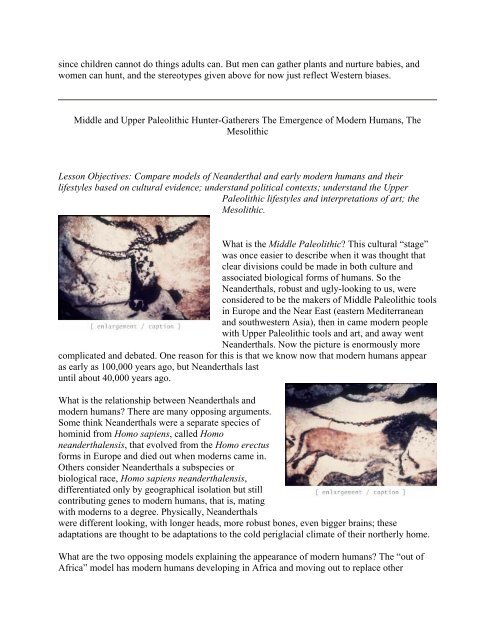INTRODUCTION TO ARCHAEOLOGY Nancy White - Touro Institute
INTRODUCTION TO ARCHAEOLOGY Nancy White - Touro Institute
INTRODUCTION TO ARCHAEOLOGY Nancy White - Touro Institute
You also want an ePaper? Increase the reach of your titles
YUMPU automatically turns print PDFs into web optimized ePapers that Google loves.
since children cannot do things adults can. But men can gather plants and nurture babies, and<br />
women can hunt, and the stereotypes given above for now just reflect Western biases.<br />
Middle and Upper Paleolithic Hunter-Gatherers The Emergence of Modern Humans, The<br />
Mesolithic<br />
Lesson Objectives: Compare models of Neanderthal and early modern humans and their<br />
lifestyles based on cultural evidence; understand political contexts; understand the Upper<br />
Paleolithic lifestyles and interpretations of art; the<br />
Mesolithic.<br />
What is the Middle Paleolithic? This cultural “stage”<br />
was once easier to describe when it was thought that<br />
clear divisions could be made in both culture and<br />
associated biological forms of humans. So the<br />
Neanderthals, robust and ugly-looking to us, were<br />
considered to be the makers of Middle Paleolithic tools<br />
in Europe and the Near East (eastern Mediterranean<br />
and southwestern Asia), then in came modern people<br />
with Upper Paleolithic tools and art, and away went<br />
Neanderthals. Now the picture is enormously more<br />
complicated and debated. One reason for this is that we know now that modern humans appear<br />
as early as 100,000 years ago, but Neanderthals last<br />
until about 40,000 years ago.<br />
What is the relationship between Neanderthals and<br />
modern humans? There are many opposing arguments.<br />
Some think Neanderthals were a separate species of<br />
hominid from Homo sapiens, called Homo<br />
neanderthalensis, that evolved from the Homo erectus<br />
forms in Europe and died out when moderns came in.<br />
Others consider Neanderthals a subspecies or<br />
biological race, Homo sapiens neanderthalensis,<br />
differentiated only by geographical isolation but still<br />
contributing genes to modern humans, that is, mating<br />
with moderns to a degree. Physically, Neanderthals<br />
were different looking, with longer heads, more robust bones, even bigger brains; these<br />
adaptations are thought to be adaptations to the cold periglacial climate of their northerly home.<br />
What are the two opposing models explaining the appearance of modern humans? The “out of<br />
Africa” model has modern humans developing in Africa and moving out to replace other
















